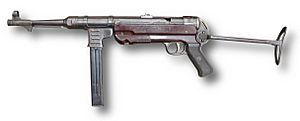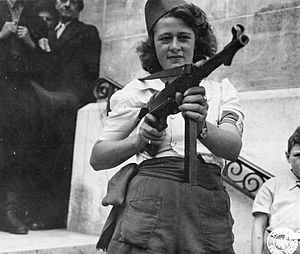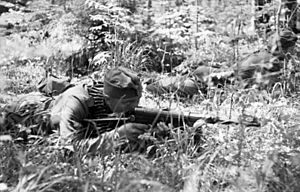MP 40 facts for kids
Quick facts for kids Maschinenpistole 40 |
|
|---|---|

A Maschinenpistole 40 made by Erma Werke in 1943 with the stock unfolded
|
|
| Type | Submachine gun |
| Place of origin | Nazi Germany |
| Service history | |
| In service | 1939 – 1945 (Nazi Germany) 1940 – present (other countries) |
| Used by | See Users |
| Wars |
|
| Production history | |
| Designer | Heinrich Vollmer Berthold Geipel |
| Designed | 1938 |
| Manufacturer |
|
| Unit cost | 57 ℛℳ (1940) Error when using : |start_year=1940 (parameter 3) is lower than the earliest available year (1951) in index "DE". EUR current equivalent |
| Produced | 1940–1945 (MP 40) |
| No. built | 1,100,000 (estimated) |
| Variants |
|
| Specifications | |
| Mass | 3.97 kg (8.75 lb) |
| Length | 833 mm (32.8 in) stock extended/630 mm (24.8 in) stock folded |
| Barrel length | 251 mm (9.9 in) |
|
|
|
| Cartridge | 9×19mm Parabellum |
| Action | Straight blowback, open bolt |
| Rate of fire | 500–550 rounds/min |
| Muzzle velocity | 400 m/s (1,312 ft/s) |
| Effective firing range | 100–200 m |
| Maximum firing range | 250 m |
| Feed system | 32-round detachable box magazine, 64-round with dual magazines |
| Sights | Hooded front blade |
The MP 40 (which stands for Maschinenpistole 40, meaning "Machine pistol 40") is a type of submachine gun. It uses 9×19mm Parabellum bullets. This weapon was first made in Nazi Germany. It was widely used by the Axis powers during World War II.
Heinrich Vollmer designed the MP 40 in 1938. He got ideas from an earlier model called the MP 38. Soldiers, especially leaders of small groups and paratroopers, used it a lot. It was used on both the Eastern and Western battlefronts of World War II. Even crews in armoured fighting vehicles found it useful.
The MP 40 had new and modern features. This made it popular with soldiers. Many countries around the world continued to use it after the war. People often called it "Schmeisser." This was after Hugo Schmeisser, who designed an older submachine gun called the MP 18. However, he was not involved in making the MP 40. About 1.1 million MP 40s were made between 1940 and 1945.
Contents
How the MP 40 Was Developed
The MP 40 came from an earlier design, the MP 38. The MP 38 itself was based on an even older model, the MP 36. The MP 36 was a test model made from machined steel. Berthold Geipel of Erma Werke developed the MP 36. The German Army helped pay for it.
Heinrich Vollmer then worked on the MP 36. In 1938, he showed a new version to the German Army. They were looking for a new submachine gun. This new version became the MP 38. The MP 38 was a simpler version of the MP 36. The MP 40 was made even simpler than the MP 38. It used more stamped steel parts instead of machined ones. This helped save time and money during production.
The Allies often called the MP 40 the "Schmeisser." This was because of weapon designer Hugo Schmeisser. He had designed the MP 18, which was the first submachine gun made in large numbers. But Hugo Schmeisser did not design or develop the MP 40. He only held a patent for its magazine.
Design and Features of the MP 40
The MP 40 submachine guns work in a simple way. They are open-bolt and use a blowback system. This means that when you pull the trigger, the bolt moves backward, loads a new bullet, and fires it. The gun can only fire automatically. However, it shoots slowly enough that a skilled user can fire single shots by pulling the trigger quickly.
An important safety feature was added to later MP 38s and all MP 40s. The cocking handle could be pushed into one of two special slots. This would lock the bolt in place, either ready to fire or completely closed. This prevented accidental firing.
The first MP 38s were made from machined steel. This process took a lot of time and was expensive. To make more guns faster and cheaper, the MP 40 used more stamped steel parts. These parts were joined together using electro-spot welding. This made production much easier.
Most MP 38 and MP 40 submachine guns have a special bar under the barrel. It was made of aluminum, steel, or a plastic called Margolit. This bar helped soldiers steady the weapon. They could rest it on the side of open vehicles like the Sd.Kfz. 251 half-track while firing. A handguard, also made of Margolit, was placed near the pistol grip. The barrel itself had no cover, so soldiers had to be careful not to burn their hands.
The MP 40 also had a metal stock that could fold forward. This was a new idea for submachine guns. It made the weapon much shorter when folded. This made it easier to carry. However, this folding stock was sometimes not strong enough for tough combat.
The MP 40 was usually a reliable weapon. But it had one main weakness: its 32-round magazine. Unlike some other guns, the MP 40's magazine fed bullets in a single line. This could cause problems if dirt got in or if the bullets didn't move smoothly. Also, soldiers sometimes held the gun by the magazine. This could cause the magazine to bend slightly, leading to jams. German soldiers were taught to hold the gun by the handguard or the magazine housing to avoid these problems.
How the MP 40 Was Used in War
At the start of World War II, most German soldiers carried either Karabiner 98k rifles or MP 40s. These were considered the main weapons for soldiers.
However, during battles like the Battle of Stalingrad, German soldiers faced Soviet troops armed with many PPSh-41 submachine guns. The Germans realized they needed more short-range firepower in city fights. So, by the end of the war, entire groups of German soldiers were sometimes given MP 40s. Starting in 1943, the German military began replacing both the Karabiner 98k and the MP 40 with a new weapon, the StG 44. By the end of World War II in 1945, about 1.1 million MP 40s of all types had been made.
MP 40 Use After World War II
After World War II, many MP 40s were captured by the Allies. Over 200,000 were taken or given up. These guns were then given to armies and special forces in many developing countries. For example, the Norwegian army used the MP 40 until around 1990. It was then replaced by the Heckler & Koch MP5.
Different Versions of the MP 40
MP 40/I
The MP 40/I was a changed version of the regular MP 40. It had a special holder for two magazines side-by-side. This meant it could hold up to 64 bullets. It was designed for special forces on the Eastern Front. The idea was to match the larger magazine capacity of the enemy's PPSh-41. However, this design didn't work well. It was too heavy and often had problems.
MP 41
In 1941, Hugo Schmeisser designed the MP 41. This gun was basically an MP 40's upper part combined with the lower part of an MP 28 submachine gun. It was not used much in combat. It was mainly given to SS and police units in 1944. The MP 41 was also sent to Germany's ally, Romania.
Later in 1941, the company Erma Werke sued Haenel, where Schmeisser worked. They claimed Haenel had copied their design. Because of this, production of the MP 41 stopped.
How the MP 40 Influenced Other Weapons
The MP 38 and MP 40 designs inspired many later weapons. These include the Spanish Star Z45 and the Yugoslavian Zastava M56.
Other submachine guns also used ideas from the MP 40, even if they were very different:
- The designers of the American M3 "Grease Gun" looked at captured MP 40s for useful ideas.
- The MP 40's folding stock became a model for later weapons. Examples include the Soviet PPS-43 and some versions of the AK-47.
- The magazine from an MP 40 can also be used in the Belgian Vigneron submachine gun.
Who Used the MP 40

During World War II, resistance fighters and the Allies sometimes captured MP 40s. They used them instead of or along with their own weapons. The MP 40 was used for many years after World War II in conflicts around the world. Some even ended up with groups like the Viet Cong.
Here are some of the groups and countries that used the MP 40:
 Algeria: Used by the National Liberation Army.
Algeria: Used by the National Liberation Army. Austria
Austria Bosnia
Bosnia Bulgaria
Bulgaria Croatia
Croatia Czechoslovakia
Czechoslovakia Finland: Used by prison guards until the 1970s.
Finland: Used by prison guards until the 1970s. France: Used by French resistance and later by the French Army.
France: Used by French resistance and later by the French Army. Greece
Greece Guatemala: Used by police until the end of the Guatemalan Civil War.
Guatemala: Used by police until the end of the Guatemalan Civil War. Hungary
Hungary Indonesia
Indonesia Israel: Used during the 1948 Arab-Israeli War.
Israel: Used during the 1948 Arab-Israeli War. Iran: Used by special military units.
Iran: Used by special military units. Italian Partisans: Captured from German soldiers.
Italian Partisans: Captured from German soldiers. Kosovo Liberation Army
Kosovo Liberation Army Nazi Germany: Used by the army, police, and even youth groups.
Nazi Germany: Used by the army, police, and even youth groups. Netherlands: Used by the Papuan Volunteer Corps.
Netherlands: Used by the Papuan Volunteer Corps. Norway
Norway Poland: Used by Polish rebels during World War II.
Poland: Used by Polish rebels during World War II. Romania
Romania Soviet Union: Used by Soviet partisans and the Red Army.
Soviet Union: Used by Soviet partisans and the Red Army. Spain: Copied as the Star Model Z-45.
Spain: Copied as the Star Model Z-45. South Vietnam: Used by the South Vietnamese Popular Force.
South Vietnam: Used by the South Vietnamese Popular Force. Syria: Used against Israel.
Syria: Used against Israel. United States: Captured by US soldiers during World War II.
United States: Captured by US soldiers during World War II. Vietnam: Captured from French forces and used by various groups.
Vietnam: Captured from French forces and used by various groups. Yugoslavia
Yugoslavia Zimbabwe: Used by ZIPRA and ZANLA.
Zimbabwe: Used by ZIPRA and ZANLA.
MP 40s in the United States
After World War II, many U.S. soldiers brought captured MP 40s home as war trophies. These guns are now very valuable.
Later, it became harder to import complete machine guns. So, people started importing parts of MP 40s (called "parts kits"). They would then build new guns using these parts and new receivers made in the U.S. These rebuilt guns are also valuable.
Today, there are also semi-automatic versions and replicas of the MP 40 available. These look like the original but work differently inside. They are often used for fun shooting or historical events.
See also
 In Spanish: MP40 para niños
In Spanish: MP40 para niños
- List of common World War II infantry weapons
- List of submachine guns
- List of World War II firearms of Germany



